
June 2004
Boyd Kirkland has worked in the animation
business for over 25 years. He ran an art studio in Salt Lake
City, Utah from 1979 to 1987 that subcontracted layout and
storyboard work from Hanna Barbera, Ruby Spears, Marvel, and other
Los Angeles animation companies. Shows worked on included
Meatballs and Spaghetti, Thundarr the Barbarian, Plastic
Man, Jana
of the Jungle, Fantastic Four, Spider-Man and His Amazing
Friends,
The Incredible Hulk, Mr. T, Puppy's New Adventures and many
others.
In 1984, Kirkland moved his family to Los Angeles,
creating storyboards for animated feature films such as Starchaser:
The Legend of Orin, GI Joe: The Movie, My Little Pony: The
Movie,
Little Nemo: Adventures in Slumberland, The Chipmunk Adventure as
well as for
|
|
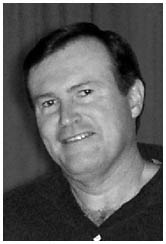
|
|
Boyd Kirkland in 2004 |
|
several TV series, including
Dungeons & Dragons, Jem, Robocop, Gummi
Bears, Visionaries, Conan, Gargoyles, The
Fantastic Four, etc. He also produced and directed several series
for Marvel Productions, including Robocop, Attack of the Killer
Tomatoes, and Bucky O'Hare.
In 1991, he served as an animation
director for Warner Bros.' Batman: The Animated Series. He also
co-directed the animated feature film Batman: Mask of the Phantasm
in 1993, and produced, co-wrote and directed Warner Bros.'
direct-to-video animated film Batman & Mr. Freeze: Subzero in
1998. While at Warner's, he also developed several proposed series
and features for the studio, including: Wonder Woman, Metal
Men, Legionnaires, Lobo, Invasion America,
Lupin the III, and Batman
and Joker in Asylum. In 1999, he directed episodes of Xyber 9 for
Saban Entertainment.
In 2000, Kirkland developed and produced
X-Men: Evolution for Marvel Entertainment. He also wrote and
directed several episodes during its successful four season run on
Kids' WB.
As of June 2004, he is developing an action series for Cartoon
Network, as well as writing a direct-to-video Catwoman animated
feature for Warner Bros. and developing a new direct-to-video
project for Marvel.
We recently sat down with Boyd to
discuss his stunning career in animation.
Q.) How did you first
become involved in the animation industry?
I always enjoyed drawing
as a kid, and got lots of encouragement from my parents and teachers
to pursue a career in art. The Walt Disney films inspired me, and
when a young teen, became an avid fan of Marvel Comics thanks to the
art of Jack Kirby, John Buscema and others. I also was inspired by
the artwork of Frank Frazetta, Al Williamson, and other fantasy
illustrators. In college, I studied illustration and photography.
After graduating, I worked as a technical
writer/illustrator/photographer for a computer company in Salt Lake
for several years. I was married, and had started a family, so the
thought of moving to Los Angeles to pursue an art career seemed out
of the question. Luckily, the animation business came to me.
|
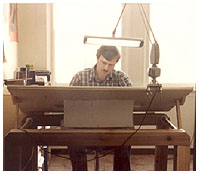
|
|
Boyd in his studio during the early 80s. |
|
|
A
couple of guys from Hanna Barbera came to Utah to set up a layout
studio for an overflow of work the company had. I saw their
classified ad and responded, giving up a secure, full-time position
to work for the summer drawing layouts for $10 a scene! Somehow, I
managed to survive, and a small group of us eventually started our
own company. At its peak, we had about 25 -30 employees, and were
getting layout work from a number of different studios. But times
were always tough. Back then, there were only three networks showing
cartoons on Saturday mornings. The syndication craze hadn't hit yet.
The work was
|
very seasonal. Eventually, the layout business got
outsourced to overseas studios, and we were out of business. Seeing
this coming, I realized I had to be in LA and diversify my talents
if I was going to stay in the business.
Q) On the '81 solo Spider-Man
show, Spider-Man & his Amazing Friends, & the '82 Hulk
cartoon you are credited in "Layout". I think most people
understand what storyboards are and how they are used, but for the
uninitiated, such as myself, what exactly is involved in the layout
process?
Boyd Kirkland:
Storyboards are small rough sketches establishing camera
angles and scene continuity, and function as the
"blueprint" for the show. Layouts are full-scale drawings
based on the storyboards. The scene's components are broken down
into different "cel levels," with all the camera mechanics
worked out. For example, the background is drawn on the bottom
level. Animation (characters, props - anything that moves) is drawn
on other levels, separating elements that overlap. Foregrounds are
drawn on the top level. Camera field sizes, start and stop positions
for "pans" or "zooms" are all worked out.
Usually, all extreme poses required by the character movement are
drawn in proper scale and registration with the background.
Sometimes backgrounds are long drawings that "pan" behind
the animation to convey the sense of movement. A big part of our job
was designing these backgrounds, as we usually got very little
reference from the studios. Here is an old layout from
Spider-Man and His Amazing Friends (be kind - I was still learning
how to draw back then!). I've compressed the various levels here
into one illustration:
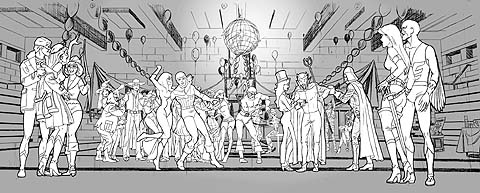
|
|
Boyd
Kirkland's layout for the costume party in the episode
"Triumph of the Green Goblin" |
Q) I can only
imagine, given your interests as a teen, what it must have felt like
to actually be working on a Spider-Man or Hulk cartoon. How did it
feel to be working on something that you had admired as a fan? Were
others that you were working with comic book fans as well?
Boyd Kirkland:
Yes, it was pretty exciting to try my hand at drawing characters I
loved as a kid. It was also a very humbling experience, as I quickly
realized how little talent I had in comparison to the comic book
artists I admired. It took me several years of drawing before I
started feeling like I knew what I was doing. College hadn't taught
me the skills I needed to do the job. Many of us were drawn to this
work because we were comic book or animation fans as kids. And it
was always a real kick the first year or two to get up on Saturday
mornings and see your work and name on TV. The novelty of that soon
wore off, though. Even doing something you love can become laborious
when you do it every day, and it becomes a means of paying the bills
and supporting your family.
Another exciting experience for me was
meeting Stan Lee. He visited our studio in Salt Lake City one year,
and really pumped up the whole crew by telling us how important
| our
work was to Marvel. I've since had the opportunity of working
with him on other occasions here in LA.
I never got to meet Jack
Kirby during my work, but did greet him as a fan at a San Diego
Comic Convention. I loved looking at his storyboards for the DePatie-
Freleng Fantastic Four show, which we drew layouts for. He also did
some inspired designs for Thundarr the Barbarian, which were fun to
draw. |
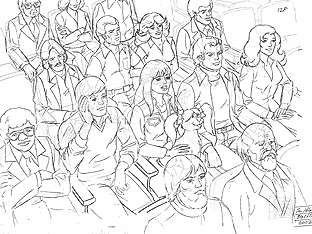 |
|
Layout
from the episode "The Crime of all Centuries" |
|
Q). Was any of your
original layout art drastically altered for a finished episode and
if so, what circumstance caused the most frustration?
Boyd Kirkland:
Not really. Sometimes the animators would improve on our character
drawings and get them more "on-model" than we
inexperienced layout artists could do. Other times, they would
"flatten out" the perspective, making things less dramatic
(but easier for them to animate). Sometimes, it was disappointing to
see really slipshod paintings of backgrounds, that lost lots of
detail, etc. from the layouts we had labored over. But since most of
these shots were only on screen for a few seconds, I can see why
underpaid and overworked background painters didn't want to labor
over them.
Q). Some comic book fans
are quite vocal in their dislike of the translation of their
favorite comic into television cartoons. What's your philosophy on
the changes made from an original source material to a new medium?
And what was your opinion of the changes made in the Marvel cartoons
of the 80s? For the record, I just want to state that X-MEN:
EVOLUTION has more charm & appeal in a 5 minute segment than the
entire Fox animated series did!
Boyd Kirkland:
Anytime you translate something from one medium into another,
changes and adaptations have to be made. Things that work well in a
comic or novel don't always translate well to film. Each medium has
its own strengths and weaknesses. Then there's also the limitations
and realities of TV budgets, schedules, and children's broadcast
standards...
During the 80's (and before), the networks were very
skittish about "action" shows because of pressures from
activist groups concerned with violence in children's programming.
Whatever did make it on the air had to be extremely watered down
from the comics. Since I wasn't involved at the story level in those
days, it wasn't particularly frustrating for me because I was happy
just to be drawing the stuff! I remember that the Hulk was
particularly problematic, because of what he's all about -
destruction! For example, when he knocked down a wall, he had to do
it with an open
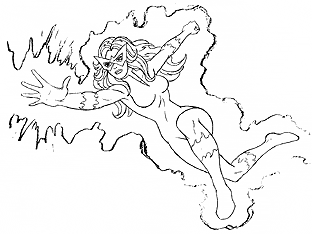 |
|
Firestar! |
|
|
hand (not with a fist)! That's how ridiculous some
of the network's rules were. The writers and storyboard artists
really struggled to interject action and excitement into the shows
given all the limitations. I recall that the Spider-Man solo series
had stories that were much more faithful to the comics. Its content
also wasn't quite as policed because it was syndicated. Spider-Man
& His Amazing Friends, however had more "network"
restrictions and impositions (they insisted
|
that it had to have a
dog in it, for example - the usual network stereotype). It
originally hit me as being an odd concept, since it varied so much
from the comics. But it turned out to be a very entertaining show,
mostly because of the humor in it. I just remember The Hulk being a
lot more work because of all the crowd scenes and destruction! And
it was tough drawing Rick Jones in that cowboy hat!
Thanks for the
compliment about X-Men: Evolution. It's disheartening to read
negative comments from fans who were disappointed because it varied
from the X-Men comic book canon. But as I explained above, that
always happens with network kids' shows. In many ways, however, I
thought the show was more character driven, "mature" and
intelligent than most other incarnations in spite of that. We always
tried to strike a balance between action, humor, pathos, and soap
opera to keep it varied and interesting within the framework the
network limited us to. I didn't want to just retell watered-down
versions of comic book stories where the comic fans would already
know the outcome.
 Q) How do you feel that storytelling methods have
changed between 1980s and modern super-hero animation?
Boyd Kirkland
Q) How do you feel that storytelling methods have
changed between 1980s and modern super-hero animation?
Boyd Kirkland: I think we really turned a corner in the early 90's with the
Batman Animated Series. Fox Kids was trying to put itself on the map, and so was
willing to take more chances and gave us more leeway regarding the
content. Warner Bros. also was very supportive, giving us about
twice the time and money usually spent on this kind of stuff. All
that, and many very talented people all came together to create
something very good that appealed to a much broader audience than
most kids' TV. Ever since then, everyone else has been trying to
play catch-up. Unfortunately, with the proliferation of channels on
cable TV, it's getting harder and harder for studios to justify
spending as much money on the shows because the audience sizes have
been dwindling. Also, on many outlets, the "watchdog"
pendulum has begun swinging back to the more conservative side.
Computers have helped improve the quality & efficiency of the
work in many ways, from coloring the animation to editing and post
production effects, sound and music. Consequently, we can be far
more ambitious in many ways, even though budgets are dwindling.
Storytelling hasn't really changed that much, except that today's
audiences who've been weaned on MTV expect things to move much
faster on screen than ever before (but that's not necessarily a good
thing, in my opinion). Good storytelling depends on fundamentals
that will always remain the same.
Q) You have had an amazing career
and have been involved in many aspects of the animation process. At
what level did you find the most satisfaction creatively?
| Boyd Kirkland: Each step
in the process has it's own rewards and challenges. Drawing layouts
really improved my basic drawing skills, teaching me a lot about
perspective, posing, line of action, etc., as well as the general
mechanics of the animation process. When I moved from layout into
storyboards, that was very exciting. It's like being the director
and cinematographer in live action, as you get to visualize the film
from the script. There were many things to learn about staging,
scene continuity, acting, visual pacing, economizing for time and
simplicity, etc. But the more storyboards I drew, the more I
realized how important a good script was to the whole process. I
also grew to appreciate the importance of timing. Many good scenes I
had visualized were ruined by being timed too fast or too slow. So
it was really great when I became a director and had more control of
those aspects of the process.
|
|
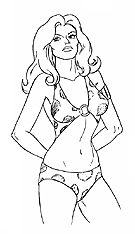 |
|
Shanna
of the Jungle |
|
As a director on Batman, I would go
over all the storyboards, making revisions and improvements;
"slug" the storyboard, determining the timing of each
shot; attend recording sessions, making suggestions about the vocal
performances; review the layouts, improving staging, character
posing, determine timing of camera moves, movement of cel levels,
etc; and I also checked the timing sheets, reviewing the breakdown
of all animation movement, lip sync, scene transitions, etc. When
the film came back from the studio overseas, I also worked with the
editor to cut the show and call retakes. But other aspects of the
process were still beyond my control.
As a producer, I finally had
some say about the initial development of the project, and had input
into the writing and storytelling process. I also art directed the
shows, controlling designs, color, background styling, etc. The
producer also helps determine the voice cast, oversees the recording
sessions, hires the crew, determines with the business manager the
various sub-contactors including the animation studio, as well as
supervises the post production process, including music scoring,
sound dubs, and on-lining where the final master print is made. The
producer is also responsible for ensuring that everything gets done
on time and on budget.
Q) What would be your absolute dream project
and what superhero would you most like to have a show about?
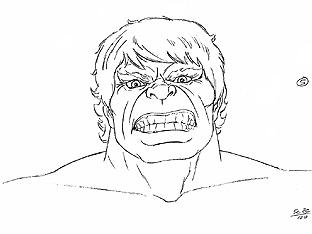 |
|
One
of Boyd's layouts from The Incredible Hulk. |
|
|
Boyd Kirkland: Of course, I've been envious of the large budgets and expansive
production schedules lavished on many animated feature films. I've
often thought how wonderful it would be to have that kind of time
and money devoted to an action-adventure cartoon. The closest things
to it are several Japanese anime features, such as Laputa: Castle in
the Sky, Akira, Ghost in the Shell, etc. The Little Nemo: Adventures
in Slumberland film I worked |
on for TMS was also very ambitious.
But
all of those projects had relatively humble budgets by Disney
standards. Unfortunately, the poor box office results of Disney and
Dreamworks' recent forays into more action-oriented fare such as Atlantis,
Treasure Planet, and Sinbad, have doomed any more of those
being made in the near future. I still believe that a well-produced
superhero or fantasy film would do well in animation. After all, a
large percentage of footage in such live-action films is computer
animation these days.
I also like the long-form story-telling
opportunities of feature length projects. And there are far fewer
restrictions regarding the content than we have to contend with on
TV. I think that enough people have grown up with video games,
cartoons, comics, etc., that a much broader audience exists out
there for something like this than most people think. It's mostly a
matter of telling an entertaining, compelling story in an exciting
way.
Picking a particular superhero as a favorite would be
difficult. You could tell great stories with many of them. But if
money were no object, I have often thought that a Tales of Asgaard
featuring Thor would be great to see on the big screen. The Galactus
story from the Fantastic Four would also be wonderful. There are
also many great fantasy novels I've read over the years with great
characters that would work well in epic films. I was thrilled to see
what Peter Jackson did with The Lord of the Rings trilogy,
demonstrating that there is an audience for fantasy if it's done
well.
| Q) At the time of this interview, Disney has given up on
their traditionally animated theatrical features due to computer
animation being extremely popular. At the risk of being stoned, I'm
going to state my personal opinion on what I think is going to
happen. MANY years down the road, I see traditional animation
becoming what stop-motion films have become: Occasional, and not an
"industry" that a large number of people could
|
|
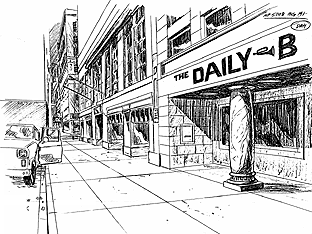 |
|
A typical
city background from the solo Spider-Man cartoon. |
|
survive in.
With that opinion in consideration, what do you think? Stone if you
must.
Boyd Kirkland: Unfortunately, you're probably right, mostly because
management no longer wishes to support traditional animation. As I
stated above, I still think there's an audience for it. It has more
to do with good story telling than with the medium being used. Final
Fantasy demonstrated that. Each medium has something to recommend
it. Pixar has been very smart about picking subject matter that
takes advantage of the strengths of CGI, while avoiding its
weaknesses. Traditional artistic mediums can create atmospheres and
moods that are impossible to convey with photography or slick CGI.
Who wants to see a CGI version of Beavis and Butthead, for example?
Would you get the same sensibilities expressed by those extremely
crude drawings? I don't think so.
Q) Any chance you'll spill the
beans about that new Marvel project you're working on?
Boyd Kirkland: I could tell
you, but then I'd have to kill you! No, actually we always sign
confidentiality agreements with the companies we work for to prevent
competitors from stealing or upstaging ideas, and to control the
publicity, etc. I'm sure Marvel will release the details when the
timing is right for them. But I think I can safely say that it will
make a lot of Marvel Comic fans extremely happy!
I can't wait! Boyd, it has been a pleasure talking to a man of your stature.
I hope you
realize the amount of joy that you bring to others!
Excelsior! 
|
|